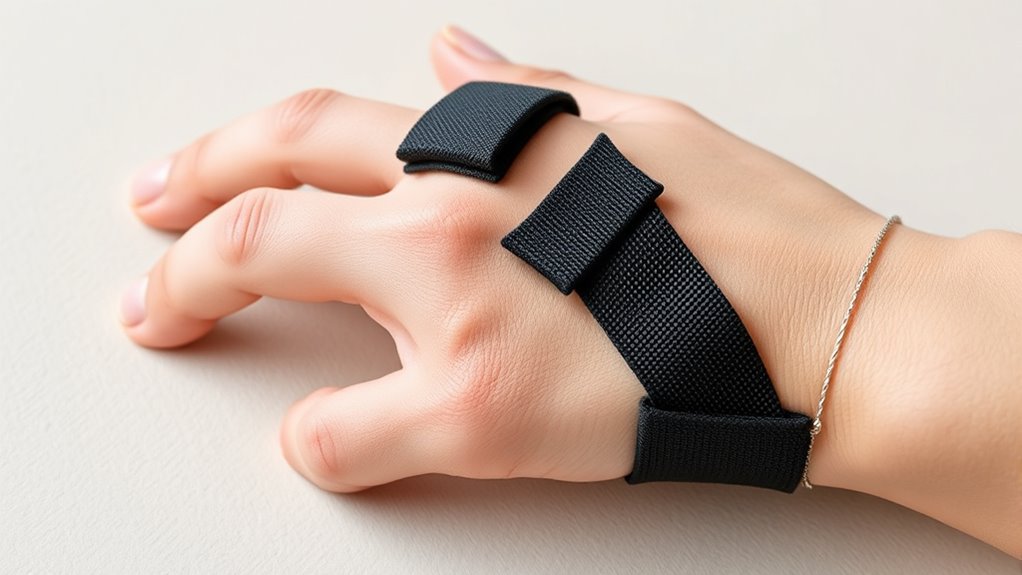There are several bracing options for thumb-base osteoarthritis, including over-the-counter supports, custom-made braces, and rigid or semi-rigid orthoses. Over-the-counter splints are convenient for quick relief, while custom braces offer a tailored fit for comfort and stability. Rigid supports provide maximum immobilization during severe pain or instability. Proper sizing, material choice, and correct wear are key for effectiveness. If you want to explore how to choose and maintain these supports, keep going for helpful tips.
Key Takeaways
- Over-the-counter supports are accessible options providing stability and pain relief for thumb-base osteoarthritis.
- Custom-made braces offer tailored fit and enhanced comfort for long-term management.
- Rigid and semi-rigid orthoses are suited for severe instability or pain, with support levels tailored to symptoms.
- Braces should be worn during activities that trigger pain or instability, with usage guided by healthcare providers.
- Proper fit, material choice, and regular maintenance are essential for effective support and comfort.
Over-the-Counter Thumb Splints and Supports

Over-the-counter thumb splints and supports are convenient options for managing thumb-base osteoarthritis. They are designed to provide stability and reduce joint strain during daily activities. You can easily find these supports at most pharmacies or online stores, making them accessible without a doctor’s prescription. They typically feature adjustable straps or rigid stays to customize fit and support. Wearing a splint can help alleviate pain, improve thumb function, and prevent further joint damage by limiting excessive movement. These supports are ideal for short-term relief or as part of a all-encompassing treatment plan. Keep in mind, choosing the right size and type is important for comfort and effectiveness. Regular use can help you maintain activity levels while protecting your thumb joint from additional stress.
Custom-Made Braces for Enhanced Fit and Comfort
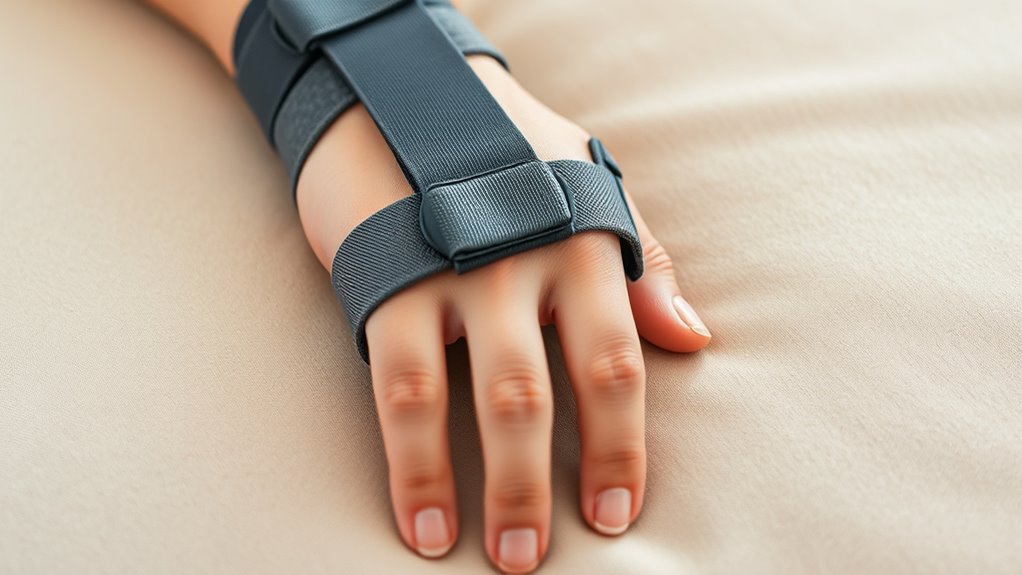
Custom-made braces offer a tailored solution for managing thumb-base osteoarthritis, providing a better fit and enhanced comfort compared to generic supports. Because they’re designed specifically for your hand, they minimize pressure points and improve stability. You’ll notice increased ease in daily activities and reduced pain. These braces are crafted based on detailed measurements and your unique anatomy, ensuring prime support. They also accommodate swelling and changes in your condition. Additionally, the personalization process allows for adjustments that can improve long-term effectiveness. Proper fit and comfort are essential components that influence the success of your treatment. Here’s how they compare:
| Feature | Custom-Made Brace | Generic Support | Cost |
|---|---|---|---|
| Fit | Precise, personalized fit | One-size-fits-all | Higher |
| Comfort | Enhanced, comfortable support | May cause discomfort | Moderate to high |
| Adjustability | Customizable for swelling | Limited or none | Variable |
| Support Level | Targeted, specific support | General support | Lower |
| Longevity | Durable with proper care | Less durable | Varies |
This customization ensures you get the best support for your specific needs. Understanding store hours can help you plan your shopping trips efficiently and avoid unnecessary wait times. Additionally, the importance of proper fit cannot be overstated in achieving optimal support and comfort, which is crucial for managing your condition effectively.
Rigid and Semi-Rigid Orthoses: When to Use Them
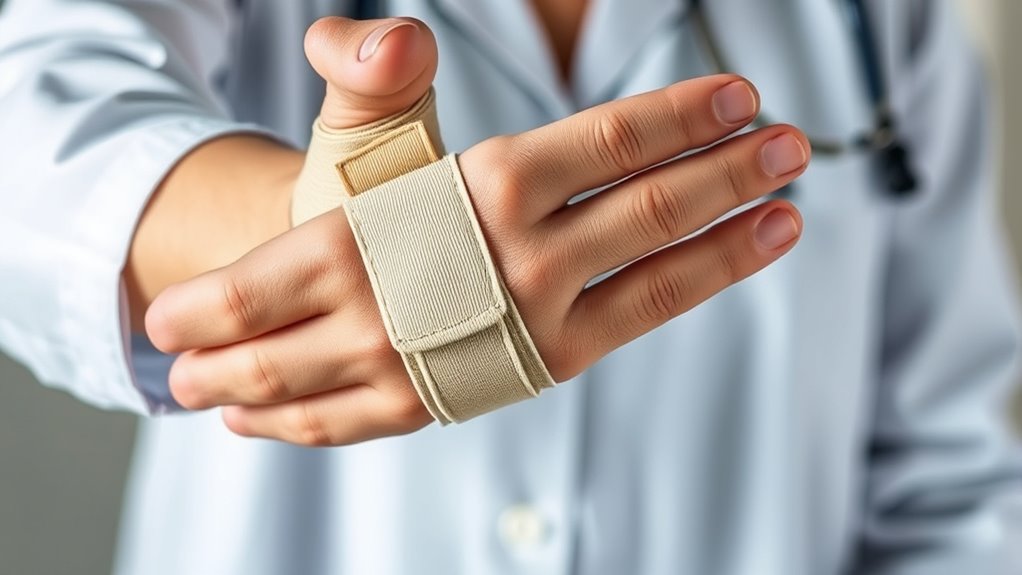
Rigid and semi-rigid orthoses are best suited for cases with significant joint instability or severe pain. You should consider semi-rigid options for moderate support, switching to rigid braces when extra stability is needed. Keep in mind the timing and duration of wear to maximize benefits without causing discomfort or dependency.
Indications for Rigid Supports
Rigid supports are indicated when your thumb requires considerable stabilization to manage pain, improve function, or prevent joint deterioration. If you experience persistent instability or weakness that hampers daily activities, a rigid orthosis can provide the necessary immobilization. They are ideal when conservative measures fail to control symptoms or when there’s a risk of further joint damage. Rigid supports are especially beneficial in cases of severe osteoarthritis with joint deformity or subluxation, where extra stability helps reduce pain and prevent progression. You should consider these supports if you need to limit thumb movement completely or markedly restrict motion to protect the joint during activities that aggravate symptoms. Overall, rigid supports are best suited for advanced cases requiring maximum stabilization.
Semi-Rigid Versus Rigid Use
Choosing between semi-rigid and rigid orthoses depends on the severity of your thumb’s condition and activity level. If your osteoarthritis causes significant pain and instability, a rigid orthosis offers maximum support and immobilization, helping to reduce joint stress. Rigid braces are ideal for acute flare-ups or after procedures when complete immobilization is necessary. In contrast, semi-rigid orthoses provide a balance of stability and flexibility. They are suitable for ongoing management, allowing some movement to prevent stiffness while still offering support. If your daily activities involve repetitive motions or you need some mobility during treatment, semi-rigid options can be more comfortable and practical. Always consider your activity demands and symptom severity when choosing the appropriate type of brace.
Timing and Duration of Wear
The timing and duration of wear for thumb orthoses depend on your specific condition and daily needs. Typically, you’ll wear the brace during activities that trigger pain or instability, such as gripping or pinching. For some, short-term use during flare-ups provides relief, while others may benefit from consistent, all-day wear to support joint stability. It’s important to follow your healthcare provider’s instructions, as overuse can lead to muscle weakness, and underuse may not provide enough support. Gradually increase or decrease wear time based on symptom response. In general, wearing the orthosis during tasks that stress the thumb helps protect the joint without causing unnecessary dependence. Regular assessments ensure you’re using the brace effectively and comfortably.
Dynamic Bracing: Combining Stability and Flexibility
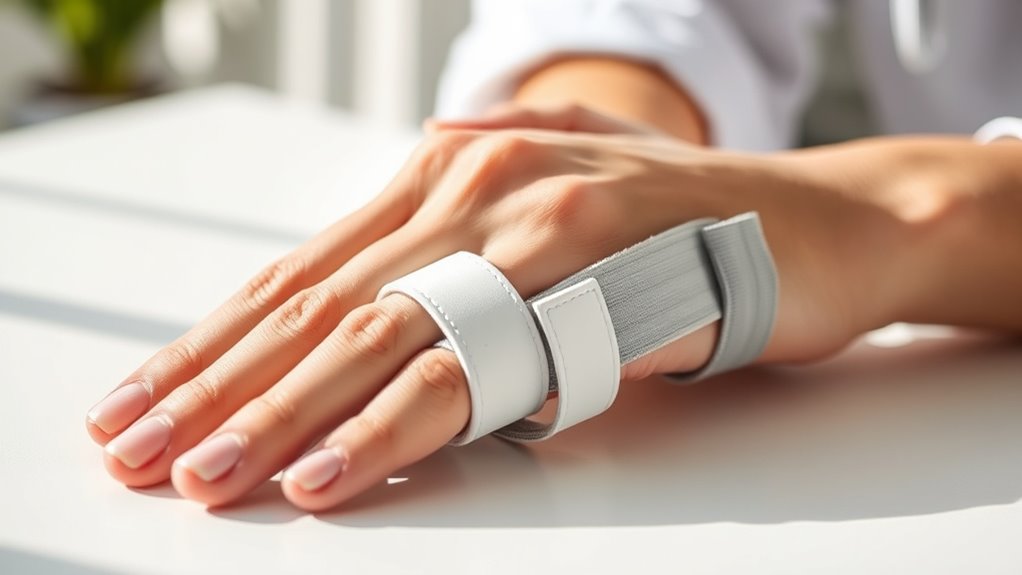
Dynamic bracing offers a practical solution by providing both stability and flexibility, allowing you to maintain functional movement while supporting the thumb base. These braces are designed with adjustable components that adapt to your activities, giving you the freedom to perform daily tasks without feeling restricted. Unlike rigid supports, dynamic braces move with your thumb, reducing stiffness and promoting natural motion. They help stabilize the joint during activity, decreasing pain and preventing further damage. You can wear them during tasks that require gripping or pinching, offering a balance between support and mobility. This approach encourages continued use of your thumb in everyday activities, which is essential for maintaining strength and dexterity. Incorporating protective styling into your management plan can also help prevent additional strain on the joint. Additionally, choosing appropriate materials ensures comfort and durability, enhancing your adherence to wearing the brace. Dynamic bracing therefore aligns with your goal of managing osteoarthritis while preserving as much function as possible.
Choosing the Right Size and Material for Your Needs

Selecting the right size and material for your thumb brace guarantees ideal comfort and support during activity. Make sure to measure your thumb and wrist accurately, following the manufacturer’s sizing chart. A well-fitting brace prevents slipping, chafing, or pinching, ensuring consistent support. When choosing materials, consider your activity level and skin sensitivity. Rigid plastics provide strong stabilization but may feel less comfortable for prolonged wear, while soft fabrics offer breathability and flexibility. Some braces combine both for optimal support and comfort. If you have sensitive skin, look for hypoallergenic options. Remember, a properly selected size and material help you stay comfortable, maintain mobility, and effectively manage thumb-base osteoarthritis symptoms. Incorporating proper support techniques can further enhance your comfort and the effectiveness of your thumb brace. Additionally, choosing durable and breathable materials can contribute to better long-term comfort and skin health. For those engaging in high-impact activities or extended wear, exploring advanced material technology may offer additional benefits. Understanding the importance of custom fit can also lead to improved support and reduced discomfort over time. To optimize your experience, consulting with a healthcare professional about individualized fitting can be very beneficial.
Tips for Wearing and Maintaining Your Thumb Braces
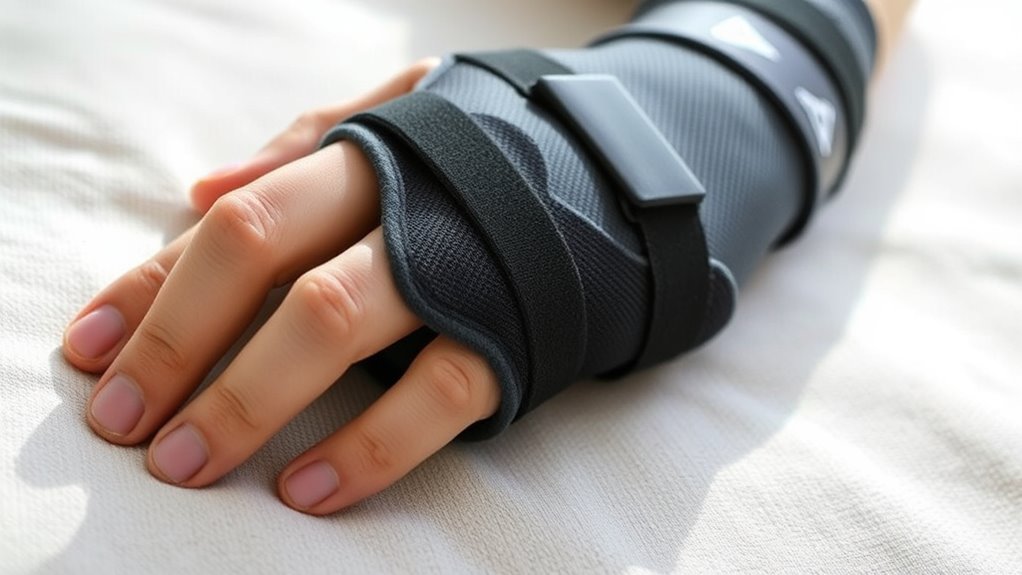
To guarantee your thumb brace provides maximum benefit, it’s important to wear it correctly and maintain it regularly. Always follow the manufacturer’s instructions for donning and doffling your brace. Ensure it fits snugly but isn’t too tight, which can restrict circulation or cause discomfort. Check the fit daily, especially if swelling or pain changes. Keep your brace clean by washing it as recommended—most are hand washable with mild soap and air-dried. Avoid exposing it to heat or direct sunlight, which can damage materials. Inspect it regularly for signs of wear, tears, or broken fasteners, and replace it if needed. Proper maintenance helps prolong the brace’s effectiveness and keeps your thumb comfortable, supporting your osteoarthritis management effectively.
Frequently Asked Questions
Can Thumb Braces Be Used During Sports Activities?
You might wonder if thumb braces are suitable during sports activities. Generally, they can be helpful in protecting your thumb and providing stability, but it depends on the type of sport. For high-impact or contact sports, specialized braces designed for activity are recommended. Always check with your healthcare provider to guarantee the brace offers enough support without restricting your movement or risking further injury during your chosen activity.
How Long Should I Wear My Thumb Brace Daily?
Wearing a thumb brace is like giving your joint a much-needed timeout. You should wear it as recommended by your healthcare provider, usually for several hours a day, especially during activities that worsen your pain. Don’t overuse it, as too much can weaken your muscles. Typically, wearing it during daytime activities and removing it at night helps protect your thumb without losing mobility. Follow your doctor’s advice for best results.
Are There Risks of Skin Irritation From Braces?
You might worry about skin irritation from wearing a brace, and it’s a valid concern. If you wear it too tightly or for extended periods, it can cause redness, chafing, or even sores. To minimize risks, make certain your brace fits well, take breaks if you notice discomfort, and keep the skin clean and dry. If irritation persists, consult your healthcare provider for adjustments or alternative options.
Can Braces Help Prevent Progression of Osteoarthritis?
Braces can help slow the progression of thumb-base osteoarthritis by providing support and reducing joint strain during daily activities. They stabilize the joint, minimize pain, and prevent further damage from repetitive movements. While they won’t completely stop osteoarthritis from advancing, wearing a brace consistently can improve your hand function and comfort, helping you maintain activity levels and potentially delaying the need for more invasive treatments.
What Are Signs That My Brace No Longer Fits Properly?
A snug brace feels supportive, but if it starts causing discomfort or slipping, it’s time to verify the fit. You might notice increased pain, redness, or skin irritation where it contacts your skin. If you feel tightness, numbness, or your thumb no longer moves freely, these are signs it’s too tight or no longer fitting properly. Always guarantee your brace feels secure without cutting off circulation or causing pain.
Conclusion
Don’t let concerns about comfort hold you back—there are plenty of brace options that fit well and ease your pain. Whether you prefer over-the-counter support or custom-made braces, the right choice can improve your daily life. Remember, wearing your brace regularly can slow osteoarthritis progression and reduce discomfort. Give it a try; with the right fit and proper use, you might find relief faster than you think.
